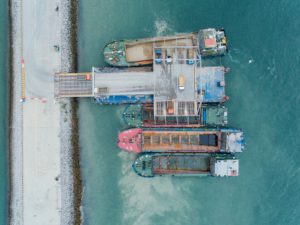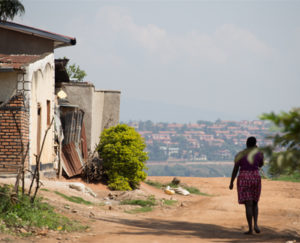How can trade policy be used to transform African livelihoods?

How can African countries and the international community overcome the existing challenges to building the poverty-reducing trade needed to meet the poverty-related Sustainable Development Goals in Africa? Lily Sommer and David Luke from UNECA, and associates of TKE Partner ICTSD, tackle these questions.
18 October 2016
To date, Africa’s progress in poverty reduction has been disappointing. Africa is the only developing region for which the Millennium Development Goal (MDG) of halving poverty was not met. The number of extremely poor Africans increased by more than 100 million between 1990 and 2012. Over the same period, the share of extremely poor Africans in the population declined from 57 percent to 43 percent. This represents about a 25 percent reduction, half of what was targeted under the MDGs. The world’s extreme poor are expected to be increasingly concentrated in Africa over the new 2030 Agenda for Sustainable Development period. In addition, deprivation is not confined to income poverty. Africa, excluding North Africa, has the world’s highest poverty rates as measured by the Multi-dimensional Poverty Index (MPI).
These persistent levels of high poverty in Africa are not a result of a lack of growth. In fact, the continent’s economies grew at an average of at least five percent above the global average of three percent over the MDG period. The problem was that this growth was not well-distributed, so it failed to lift more people out of poverty. At a time when the implementation of the 2030 Agenda has just started, it is clear that fresh thinking is needed on how to meet the challenge of inclusive growth and achieve the poverty-related Sustainable Development Goals (SDGs) on the continent.
 Trade has a key role to play, although it has been under-exploited thus far in Africa. In particular, specific emerging policy reforms may provide significant momentum for progress. The establishment of a continental free trade area (CFTA) and an emphasis on boosting intra-African trade are key priorities of the continent’s development vision, the African Union’s “Agenda 2063 – the Future We Want for Africa.” This ambitious trade agenda is reinforced by important trade-related targets that are included as means of implementation for the SDGs, and the Addis Ababa Action Agenda (AAAA) contains several other trade elements.
Trade has a key role to play, although it has been under-exploited thus far in Africa. In particular, specific emerging policy reforms may provide significant momentum for progress. The establishment of a continental free trade area (CFTA) and an emphasis on boosting intra-African trade are key priorities of the continent’s development vision, the African Union’s “Agenda 2063 – the Future We Want for Africa.” This ambitious trade agenda is reinforced by important trade-related targets that are included as means of implementation for the SDGs, and the Addis Ababa Action Agenda (AAAA) contains several other trade elements.
Why has Africa failed to use trade as an effective tool for poverty reduction? The answer is that a robust policy response is required to meet the challenges of inclusive, diversified, and transformative trade. Trade costs and services restrictions are relatively high on the continent. Average tariffs for intra-African exports are higher than for exports to the  rest of the world, which is further discussed below. Limited productive capacities have boxed African countries into the export of primary commodities with little value added. High global commodity prices only served to increase Africa’s commodity dependence and aggravate inequalities within and between African countries. In addition, while the global trade regime falls short of what is needed for Africa, mega-regional trade agreements (MRTAs) and reciprocal trade agreements with the EU are expected to create additional challenges for Africa’s structural transformation. The current slowdown in global trade and growth will also make poverty-reducing trade even more difficult.
rest of the world, which is further discussed below. Limited productive capacities have boxed African countries into the export of primary commodities with little value added. High global commodity prices only served to increase Africa’s commodity dependence and aggravate inequalities within and between African countries. In addition, while the global trade regime falls short of what is needed for Africa, mega-regional trade agreements (MRTAs) and reciprocal trade agreements with the EU are expected to create additional challenges for Africa’s structural transformation. The current slowdown in global trade and growth will also make poverty-reducing trade even more difficult.
Overcoming these challenges will not be easy. The nine key trade policy actions discussed in the remainder of this article, however, can go a long way towards trade reforms that can contribute more effectively to poverty reduction and the achievement of the 2030 Agenda in Africa.
Enhancing regional integration: the top priority for Africa
Intra-African trade has great potential to facilitate economies of scale, diversification, and value addition. In 2013, about two thirds of intra-African trade was in manufactured products. However, intra-African exchanges stood at just 16.3 percent of total African trade in the same year, providing significant scope for expansion. We propose three strategic policy imperatives that are needed to harness this potential and fast track the continental integration agenda.
Timely implementation of an inclusive CFTA agreement
The average applied rate of tariff protection within Africa is 8.7 percent, compared to only 2.5 percent imposed on the rest of the world. Disciplines are also needed for non-tariff barriers. Timely implementation of the CFTA would allow to rectify this and also offset the expected negative impact of MRTAs on preference erosion and the increased reciprocity of the Economic Partnership Agreements (EPAs). Modelling work at the ECA indicates strong positive impacts of the CFTA on intra-African trade – which is already more diversified than Africa’s trade with the rest of the world – as well as on real incomes and industrial development. Real wages for all categories of African workers are shown to receive a positive boost from the CFTA, with unskilled workers benefiting the most.[1] To ensure the realisation of these positive welfare impacts, safeguards are needed to protect agriculture livelihoods, along with a mechanism to review the CFTA’s impact on trade and poverty running up to 2030.
Supportive non-tariff policy initiatives to enable firms to take advantage of the CFTA
To date, implementation of the Boosting Intra-African Trade (BIAT) initiative has been disappointing, slow, and uncoordinated. In order to reduce the relatively high costs to intra-African trade, this must change. Mainstreaming the seven BIAT clusters – trade policy, trade facilitation, productive capacity, trade-related infrastructure, trade finance, trade information and factor market integration – into the development policy and programmes of African countries and regional economic communities (RECs) would go a long way in achieving this. In particular, efforts to enhance cross-border infrastructure should continue to receive attention. African leaders must take full ownership of the continent’s infrastructure agenda and adopt innovative financial strategies to mobilise funds required for its implementation. As the scope of the CFTA includes services, its aim should also be to increase the degree of services liberalisation beyond the current status in the RECs.
Establishment of a Continental Customs Union (CCU) supportive of structural transformation
The trade-weighted applied tariff on industrial products in least developed countries (LDCs) is 18 percent for intermediates, compared to 12 percent for finished products. High import costs for intermediates is constraining industrialisation in Africa, where intermediates account for a stable share of 60 percent of merchandise imports.[2] A CCU would help to align African countries’ attempts to achieve strategic consistency between trade and industrial frameworks, as discussed further below. ECA modelling work highlights the potential positive impacts a CCU can have on driving Africa’s structural transformation, if appropriately designed.[3] An African common external tariff (CET) should impose lower tariffs on intermediate inputs and capital goods important for industrialisation but not available locally. This would facilitate their use as imported inputs in production processes, and increase the possibilities for exporting transformed products. A sensitive item list for specific agricultural and industrial goods that are produced locally would help to avoid a rapid influx of imported goods on the African market, which could hold back domestic competitiveness, economic transformation, and poverty reduction efforts.
Harnessing regional opportunities at home: smart industrialisation through trade
Actions are needed at the national level to support regional integration and its role in industrialisation, both of which are imperative for economy-wide productivity improvement, job creation, and poverty reduction in Africa. The key lies in providing a conducive environment for the integration of African businesses into regional and global value chains (RVCs and GVCs) – in particular micro, small, and medium enterprises (MSMEs), which are key to reducing poverty through trade. Trade policy can be used in the following three “smart” ways to maximise the gains from closer regional integration and drive structural transformation and value addition in Africa.
Tariff reforms to ensure strategic consistency between trade and industrial frameworks and promote poverty reduction
African governments need not wait for a CCU to reduce tariffs on strategic industrial production inputs. Domestic tariff reforms to promote industrialisation are needed now – this will also make the process of aligning external tariff structures as part of an African CET easier further down the line. Governments should lower protection for imported intermediate and capital inputs such as fertilisers, machines, and spare parts that are crucial to industrialisation but not produced locally. Tariffs should also be reduced on energy-access technologies, which are seldom manufactured in African countries. These interventions would cut costs of industrialisation and foster domestic value addition in RVCs, thereby facilitating integration into higher rungs of GVCs. Such smart industrialisation through trade is not a new concept. The East Asian Tigers all benefited from deliberate trade policies. To avoid a sudden fiscal shock due to loss of tariff revenues, however, there is a strong case for development partners to support compensation schemes over the Agenda 2030 period.

Appropriate intellectual property (IP) policies to support the cross-border transmission of knowledge and innovation
To facilitate technological transmission and catch-up, the global IP system provides flexibilities for LDCs in the Agreement on Trade-Related Aspects of Intellectual Property Rights (TRIPS). Using these flexibilities can be helpful in building the competitiveness needed to integrate into GVCs and ensuring income convergence with developed countries and poverty reduction more generally. The Association of Southeast Asian Nations (ASEAN) countries rarely sign external agreements that are stricter than their global IP obligations, for example, and eligible members have also exploited flexibilities offered by the global IP system. This has helped to transform ASEAN into an innovative and competitive bloc.[4] African countries must be supported to establish domestic IP policies and laws that are appropriate to their level of development. The CFTA agreement provides a perfect opportunity for Africa to set common IP rules and use flexibilities based on a common approach.
Effective and efficient services that facilitate trade and investment
Services trade restrictions do not feature prominently in the 2030 Agenda, yet competitive services are key to poverty reduction since they improve downstream productivity, cut business costs, enhance access to GVCs and generate employment. Liberalisation of services sectors that facilitate trade, investment, and MSME competitiveness should thus be prioritised to secure quick gains for African economies. As noted above, services liberalisation and the establishment of common regulatory frameworks are part of the CFTA negotiating agenda.
A global trade regime that addresses Africa’s needs
The international trade landscape will influence how well Africa can take advantage of welfare-enhancing trade opportunities. Very little has been achieved under the Doha Development Agenda and there is broad consensus that, overall, the outcomes of the 2015 WTO 10th Ministerial Conference were sub-optimal. As the WTO’s post-Nairobi work programme is being developed, African countries should continue to push for multilateral trade reform. In addition to these efforts, three critical areas of support are required from the international community.
 Move beyond the 2030 Agenda’s focus on market access
Move beyond the 2030 Agenda’s focus on market access
African countries already benefit from duty-free quota-free (DFQF) access in their main foreign markets. The priority for the continent is support to mobilise productive capacities, alongside more generous rules of origin to stimulate investment, boost exports, and address Africa’s development needs. Flexible requirements for domestic value added and cumulation zones extending beyond narrow regional groupings would encourage diversification, local and regional processing, and integration into GVCs.
Appropriately manage tariff reductions contained in reciprocal trade agreements
A shift towards greater reciprocity in Africa’s trade agreements is expected over the next decade. The recently agreed EPAs between the EU and regional African groupings, while asymmetric, call for the partial and gradual opening of African markets to EU imports. In 2025, the African Growth and Opportunity Act (AGOA) is also expected to be succeeded by an agreement with a more reciprocal structure. Tariff reductions on imports from outside Africa need to be appropriately phased, so that African industries have time to adapt. Tariffs on intermediate and capital goods not produced locally could be removed first, followed by tariffs on intermediate and capital goods for which some domestic and regional production exists, and finally by tariffs on finished products. This sequencing would support Africa’s industrialisation and technological catch-up, while also providing temporary protection for local producers to guard against premature de-industrialisation. Agreements should also contain provisions that African countries can use for industrialisation purposes, as in the proposed East African Community EPA. It is imperative that signatory countries undertake comprehensive analyses of new agreements’ implications on industrial development and poverty reduction.
Improve the targeting of Aid for Trade (AfT)
 Empirical studies show that AfT can support poverty reduction through increased export diversification, employment, and foreign direct investment. Although boosting intra-African trade in particular would offer significant gains for Africa in terms of export diversification and poverty reduction, regional AfT is lacking. CFTA implementation would benefit from short-term regional AfT support. For example, although revenue losses from tariff reductions are expected to be small given the relatively low level of intra-African trade, adjustment assistance from donors may be required to meet budget shortfalls, especially in the current context of low commodity prices.
Empirical studies show that AfT can support poverty reduction through increased export diversification, employment, and foreign direct investment. Although boosting intra-African trade in particular would offer significant gains for Africa in terms of export diversification and poverty reduction, regional AfT is lacking. CFTA implementation would benefit from short-term regional AfT support. For example, although revenue losses from tariff reductions are expected to be small given the relatively low level of intra-African trade, adjustment assistance from donors may be required to meet budget shortfalls, especially in the current context of low commodity prices.
Conclusion
Although Africa is unlikely to eliminate extreme poverty by 2030, it can make serious strides in this direction. The policy actions presented above all point to the need for economic transformation in order to support Africa’s poverty-reduction agenda. This is the key to creating decent jobs, improving productivity, increasing incomes, reducing vulnerability and risks, and overcoming poverty in Africa. In particular, industrial development must become the core objective of trade policy for African governments, RECs, and the international community.
In this context, the importance of regional integration should not be underestimated. Closer collaboration and increased intra-African trade is required if Africa is to benefit from economies of scale and develop significant RVCs. Intra-African trade has already proved to be an important source of industrial upgrading and export diversification on the continent, yet it has a lot more to offer.
This piece is based on a longer paper which is published by ICTSD here. The views expressed in this article are the authors’ own and may not necessarily reflect the position of UNECA.
Authors: Lily Sommer, Trade Policy Fellow at the African Trade Policy Centre (ATPC) in the Regional Integration and Trade Division (RITD) at the United Nations Economic Commission for Africa (UNECA). David Luke, Director of the African Trade Policy Centre (ATPC) in the Regional Integration and Trade Division (RITD) at the United Nations Economic Commission for Africa (UNECA).
[1] See United Nations Economic Commission for Africa, “Assessing Regional Integration in Africa V: Towards an African Continental Free Trade Area,” 2012.
[2] United Nations Economic Commission for Africa, “Economic Report on Africa 2015: Industrializing Through Trade,” 2015.
[3] See Mevel, Simon and Stephen Karingi, “Deepening Regional Integration in Africa: A Computable General Equilibrium Assessment of the Establishment of a Continental Free Trade Area followed by a Continental Customs Union,” Paper presented at the 7th African Economic Conference, 2012.
[4] United Nations Economic Commission for Africa, “Assessing Regional Integration in Africa VII: Innovation, Competitiveness and Regional Integration,” 2016.
This article is originally from the website of TKE partner, ICTSD. It was published in their monthly review focused on trade and sustainable development issues in Africa, Bridges Africa (Volume 5- Number 8, “Trade as a tool to achieve the SDGs in Africa” ).